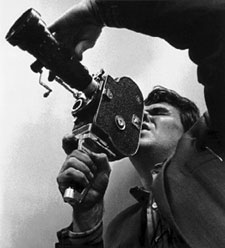

By Douglas Singleton
Avant-garde filmmaker Stan Brakhage died at the age of 70 in 2003 and his passing was felt greatly throughout
the film and art worlds. Brakhage was one of the most influential artists of the 20th century, his explorations
into film abstraction were some of the purest displays of devotion to artistic principles one is likely to find.
Back in Chicago a number of years ago, my roommate was completing an MFA in film and new media studies at the
School of the Art Institute of Chicago. It was here that I first heard names like Maya Deren, Jonas Mekas,
Harry Smith, and often, most often, "Brakhage." He was held in such high esteem that his work took on a mythic
aura before I'd ever seen any of his films.
My curiosity with Brakhage's work lies in his progression from "realistic" film imagery (i.e. people, architecture, nature)
to abstraction fashioned through superimposition and rapid film cutting (even more so than Godard's MTV-
anticipating À Bout De Soufflé) and eventually on to pure abstraction by way of physically transforming film stock
by painting onto and "scratching" the surface of raw film. Progressively, he perfected this process and aesthetic
approach until he'd gotten to a point in late films of his career such as the Ellipses series where this form of
abstraction was the sole manner in which he wanted to create a logical progression. Some of Brakhage's health problems
were a result of this technique of applying paint directly to film stock or scratching the emulsion off of film-he
suffered a little for the art. Poet Steve Dalachinsky, a friend of Brakhage's, spoke at a tribute held at the
alternative space Galapagos in Brooklyn, New York, shortly after his death where he recalled spying Brakhage
scratching onto film stock whenever he got a moment away from his friends.
The program at Galapagos included an early example of Brakhage, In Between (1955), with music by John Cage. The
film is not necessarily representative of his work. It seems staged, an almost "Technicolor" feel to it, with ample
sound and musical accompaniment as opposed to his silent diary films, Window Water Baby Moving (1959) or Loving (1957)
with deconstructed/reconstructed images of he and his family. Wonder Ring (1955) is a silent piece he made in
collaboration with American surrealist artist Joseph Cornell, in which Brakhage took a 16mm camera onto the elevated
train line that ran along Third Avenue in New York City months before it was to be torn down. The film is a beautiful,
flowing assemblage of subway car imagery, the rail line itself, buildings viewed out of the windows of trains and
twilight abstractions of people moving in and out of subway stations circa the 50s. It is a hauntingly beautiful film,
a chronicle of human architecture and urban experience abstracted into elegiac, visual poetry.
By Mothlight, (1963), Brakhage was comfortable working in sumptuous color having abandoned recognizable imagery.
He created abstraction by manipulating film stock-in this case with moth wings applied directly to the film stock
heated with light. Mothlight is an organically beautiful watershed. But, of course, it was just the beginning-the
film is only four minutes long.
Dog Star Man (1961-1964) can be interpreted as a culmination of all of Brakhage's work, representative of his whole
oeuvre, the various styles-diarist family log, cinematic narcissism, meditations on space, the usurpation of both
time and visual expectation and the physical manipulation of film stock. It is a cycle of films consisting of a prelude
and four "chapters" and runs approximately an hour. It indeed requires some mental diligence to get through. These
films exhibit significant technical virtuosity, a synthesis of Brakhage's techniques up to that point in his career.
He then took off into the stratosphere: stark images of the cosmos and exploding stars, pumping organs within the
body, his wife breastfeeding their child, nature, nudity, sex, Brakhage himself endlessly climbing a mountain in the
snow, struggling with his dog at his side. Multiple superimpositions, fades, black screens, all juxtaposed with some
of his most eloquent film treatment techniques are on ample display.
Stan Brakhage felt that cinema, film, could be music. Not musical, like Welles or Chaplin, but actual music, a piece
of sui generis art in itself. Many of his works have more in common with Jackson Pollock than they do with
cinema-"motion" drip paintings. Mekas recalled Brakhage relating a story in which a "spiritualist" told Brakhage
that he could beat the cancer eating away at him by "channeling into his body" and confronting the cancerous cells
one at a time. Brakhage said that eventually he was indeed able to get inside of himself and confront the cells eating
away at his body, but that when he did so he could not destroy them-he found them too beautiful. He let them alone. I
suspect that even these made it into his work, perhaps as the stars of his films.
|

















